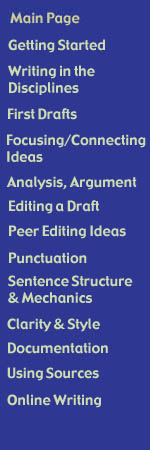

Reader-Based Response Techniques
by Joe Essid
(printable version here)
Scholar, program director, and writing teacher Peter Elbow changed classroom instruction with a few techniques he invented. These may prove useful to faculty and students looking for clever ways to help writers see how their work sounds to readers.
Finding the Center of Gravity:
Elbow described readers giving feedback as "movies of the reader's mind" as they read drafts. Try these techniques:
- Identify the draft's "center of gravity": What idea or claim most compelled your attention when reading? Ask the writer what she intended that center to be. Reader and writer need to agree.
- Go through the draft and sum up, informally, what you see happening in each section. That should match (or shape) the writer's intention.
- Summarize the draft in one word. I find this hard to do, but can you, as reader, sum up the most memorable point quickly? Then ask the writer if that is what she wants readers to most recall, later.
The Believing and Doubting Games:
Elbow details ways in which readers can balance the acts of believing and doubting what a writer sets down in a draft. The process of believing is far harder for academic readers! While no short page here can address the nuances of these techniques, a few guidelines may prove interesting and productive. After all, all academic writing consists of claims and evidence. So try these two activities in sequence.
- To play the believing game, read the draft through and assume that every claim the writer makes is one you accept. Then let the writer know which claim is most powerful or interesting to you.
- To play the doubting game, question every assumption and claim. Consider the basis for it and the evidence provided. What can the writer do to address your doubts?
For more, consult Elbow, Peter, Writing Without Teachers, Oxford, 1973, and Writing With Power, Oxford, 1981.
Back to 'Peer Editing Ideas'
Writer's Web | Writing Center | Make
an Appointment | Library
Copyright Info